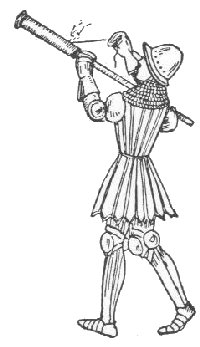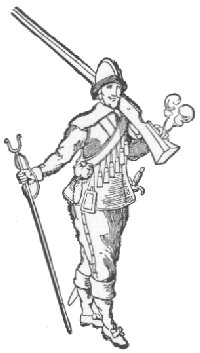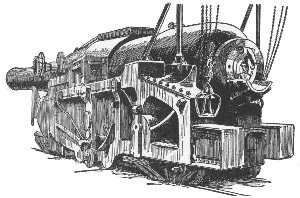FROM MUSKET TO MACHINE GUN
The Civilizing Effect of Artillery—Breech-loading—The Flintlock— Rifling—The Cartridge—Magazine Rifles—The Weapons of Modern Armies.
That it was great pity, so it was, I Henry IV, I, 3
That villainous saltpetre should be digg’d
Out of the bowels of the harmless earth,
Which many a good tall fellow had destroy’d
So cowardly.
SHAKESPEARE’S opinion of firearms and explosives has, no doubt, been shared by thousands in every age, yet for all that it must be remembered that it was the invention of gunpowder which brought the Feudal Age to an end. Before its invention, the great keeps of the robber barons were impregnable, and so long as those conditions remained civilization was in chains and liberty was impossible. When cannon loaded with gunpowder were able to batter down the towering stone walls of the castles an unbearable tyranny gradually disappeared.
There is another thing to be said in favor of firearms. In olden days, when the soldier’s weapons were the bow and the sword, the art of war was easy and the entire manhood of a tribe or a nation could be turned, if need be, into the field to fight at the shortest notice. But the invention of firearms made the art of war more difficult, and to turn the citizen into the soldier a period of training became absolutely necessary. So, by degrees, instead of every able-bodied man being ordered out to fight, comparatively small standing armies came into being, and before the Great War there was actually less slaughter in battle than in the days before guns and gunpowder were invented.
Cannon of a sort were used by the Arabs in the eighth century. "Manjaniks" they called them, and the Crusaders brought them to Europe; but, as I have mentioned
 |
Breech-loading cannon were known as early as the sixteenth century, and in the War Museum at Lisbon you may see guns of this type which are more than three hundred years old. Attempts were also made in quite early days to produce a sort of machine gun. The French orgue des bombardes consisted of a number of gun barrels fixed together upon an axle between two wheels, and, just as in the modern machine gun, a metal shield was used to protect the gunners. But this, like other firearms of that period, took a very long time to load and fire. All these early firearms had to be fired by means of a slow match, and if the weather was wet
 |
The first improvement over the slow match was the wheel lock, which was wound up with a key like a watch spring and, when released, produced a shower of sparks from the impact of steel upon a flint. Following the wheel lock came the simpler and cheaper flintlock, which is said to have been invented by robbers who found the slow match too visible during their night raids. Flintlocks were used for sporting guns, and were introduced into the British Army by William III. They actually remained in use until the year 1842! The "Brown Bess" used at Waterloo was a fearsome weapon, with a bore of no less than three quarters of an inch, and weighing, with its bayonet, more than eleven pounds. It was supposed to be good for a range of two hundred and twenty yards, but was so uncertain that the troops were always under orders not to fire "until they could see the whites of the enemies’ eyes." The bullet was spherical and wrapped in a "patch", a little square of greased cloth, so as to make it fit tightly in the barrel. The patch also made it easier to ram the bullet into place, an operation which, of course, had to be done with a ramrod.
The first real improvement in the firearm used by the British Army was the rifle known as the Brunswick, introduced in 1835. It was still a muzzle-loader, but was a real rifle; that is, the barrel was made with two deep grooves, and the bullet with a band to fit these grooves. The Brunswick, clumsy weapon as it was, had double the effective range of the "Brown Bess", and the regiments armed with it came to be known as the Rifle Brigade.
Sporting guns with two barrels side by side were first made in Italy in the seventeenth century, but it is on record that the art of shooting birds on the wing was first practised so long ago as the year 1580
The copper percussion cap for firing the charge in a gun or rifle was invented about the year 1816, but for a long time was used only for sporting guns and not for military weapons.
The advantages of the rifle, that is, the weapon with a grooved barrel, were recognized as early as the eighteenth century, but the objection to it was the difficulty of forcing a bullet with a ramrod down the barrel. You will easily understand that, if the bullet was made small enough to drop easily into position, it did not fill the grooves when fired; while, on the other hand, if the bullet was made larger, much time and strength were wasted in ramming it home. In 1852 a Frenchman, Minié, invented an expanding bullet, and the French Government awarded him £20,000 for his invention. As a matter of fact, the well-known English gunmaker, W. Greener, had invented a similar bullet no less than seventeen years earlier. In 1857 the British Government presented him with £1000 as an acknowledgment of his prior claim. The Minié rifle was a great success, for, when tried against the older firearm, ninety-four hits were made on the target as against only seventy-four with the musket.
The Prussian Government was the first to arm its troops with a breech-loading rifle. This was the so-called "needle gun" invented by Dreyse, and for the first time in military history the whole charge, bullet, explosive, and firing cap, were all contained in one cartridge. It was the needle gun which gave the Prussians their victories over Austria and Denmark, and which drove the French into adopting the Minié rifle for their whole army.
In 1853 the British authorities began the distribution of the Enfield rifle with a smaller bore and a lighter bullet than the older type of musket. The issue of this rifle to native troops in India was one of the major causes of the Indian Mutiny, for it was believed that the grease round the bullet was cow’s and pig’s fat, the former being defilement to the Hindus and the latter to the Mohammedans. A gunmaker named Snider invented a way of improving the old Enfield rifle and turning it into a breech loader, and, for a time, the British Army used nothing but the Snider rifle. Then in 1866 the Government offered a prize for a new army rifle, and no fewer than one hundred and four different makers competed. Nine rifles were chosen for a final test, and after a very stiff competition it was decided that Henry’s system of rifling with Martini’s breech mechanism would make the most serviceable weapon. The Henry rifle, I might mention, afterward became the Winchester, which has long been a favorite in America. The Martini-Henry had seven grooves with one turn in twenty-two inches. It was extremely accurate, and twenty rounds could be fired in fifty-three seconds.
The Martini-Henry was a capital weapon and lasted for a good many years; but toward the end of the nineteenth century numbers of magazine rifles had been invented, and these had a great pull over the single-shot rifle in that they could be fired so much more rapidly. So long ago as 1877 the Turks, though very inferior in numbers, were able to repel the Russian assaults at Plevna simply because they were armed with the Winchester repeating rifle. By 1879 nearly every European Power was experimenting with magazine rifles, and the Germans began to rearm with the Mauser. The Austrians adopted the Mannlicher rifle with the magazine in a compartment
 |
Immense care is taken in the making of British army rifles. The barrel is inspected or tested no fewer than ten times during manufacture. Seven hundred different gauges are used to check the sizes of the parts as they are made, and these gauges are true within the ten-thousandth part of an inch.
To prevent bullets flattening where they strike, they are coated with a hard metal such as an alloy of nickel. A lead bullet "mushrooms", that is, flattens on impact, and produces a most terrible wound. The Geneva Convention has prohibited the use of such missiles in warfare.
I have mentioned medieval machine guns. The first of modern machine guns was the invention of Dr. Gatling, and was used in the American Civil War, 1862-1865. The first Gatling gun had ten barrels mounted on a central shaft and revolved by hand. The cartridges were fed into the barrels automatically, and this gun could actually spray bullets at the rate of a thousand a minute. After the Gatling came the Gardner, the Nordenfelt, and Hotchkiss machine guns, and, late in the nineties of the last century, the Colt and the Maxim. The Maxim was the first machine gun to have only one barrel, which was kept cool by a water-jacket. Its inventor, Hiram Maxim, an American who lived most of his life in England, and was knighted, very cleverly used the recoil of the gun to extract the empty cartridge and thrust a fresh one into place. It can fire six hundred times in a minute; but if the firing is continuous, the water boils after some six hundred rounds, and after about a thousand requires replenishing. The operator controls the gun by pressure of the thumbs upon a "button"; so long as this button is held down, the gun goes on firing until the last cartridge is spent or the mechanism jams. The gun can be used either on a three-legged stand or on wheels, and was, at the time of its invention, an immense improvement on any former type of machine gun.
The Colt gun is an American invention in which the explosion of the charge, not the recoil, is used in its action. The hammer acts like the piston of an air pump, and, by driving a jet of air through the barrel, cools and cleans it. The whole gun weighs only forty pounds, and I remember attending its first trial in England in 1898, when the late Duke of Cambridge was present. Machine guns were used in tens of thousands during the Great War, and were very greatly improved. One of the best was the Madsen gun, invented by a Dane of that name— a gun which was very light, and which had one great advantage of most other types in that it very rarely jammed.
The machine guns principally used by the British Army in the Great War were the Vickers-Maxim and the Lewis. The former was the weapon of the regular machine-gun sections; the latter, a lighter gun, was employed by the infantry.
The Vickers-Maxim is an improved form of the machine gun originally invented by Sir Hiram Maxim. This was the first of its kind that was entirely automatic; that is, as soon as the trigger was pressed it would continue firing until the magazine, as represented by a belt of cartridges, was exhausted. The rate of fire was six hundred cartridges to the minute, while the whole gun weighed only sixty- three pounds.
The Vickers-Maxim can fire up to seven hundred and fifty shots a minute, and uses the ordinary Lee-Metford cartridges of .303 caliber; that is, just the same as those used in the rifles of the British Army. It is lighter than the original Maxim, and is sighted to a range of twenty-five hundred yards. Now, if you continue firing cartridges at the rate of ten or more a second, the barrel of your gun becomes red-hot, so it is necessary to have some way of cooling it. In the Maxim the method is similar to that employed for cooling a motor engine; that is to say, the barrel has round it a jacket of water. The jacket contains seven and a half pints of water, and it is reckoned that for every thousand cartridges fired, one and a half pints of water are turned to steam.
The Lewis is a smaller, lighter gun, so light, indeed, that at a pinch one man can handle it. Unlike the Maxim the gun is air-cooled, and was found invaluable, not only for the infantry, but also for use in all types of fighting aircraft in the Great War.
To turn from rifles and machine guns to heavy ordnance, it is curious to notice how little real progress there was in the manufacture of cannon right up to the middle of the nineteenth century. Wellington’s troops and Nelson’s sailors used cast-iron muzzle-loaders, which fired round
 |
balls packed in greasy clouts so as to make them fit the barrel. Each of Nelson’s guns required a crew of at least eight men, who, when a shot had been fired, hauled the heavy gun inboard with ropes, swabbed it out, and recharged it.
Cast iron was so apt to burst that many experiments were made with brass, bronze, and other alloys. But there was no real improvement until Armstrong of Elswick got the idea of building up a gun and shrinking over it coils of wrought iron. This was a great step forward, but not so great as that introduced by Mr. Frazer of the Royal Gun Factory, who, in 1869, substituted an inner steel tube in place of an iron one. Then began a great increase in the size of guns. The first was the famous "Woolwich Infant", made in 1872, and weighing thirty-five tons, which was rapidly followed by still bigger guns running up to eighty-one and even one hundred and ten tons. The latter were made at Elswick for the Italian Government, but two were bought by the British Government.
So long as muzzle-loading guns were used they had to be short, for it was necessary to haul them in for loading. These guns were very wasteful, for the shot left the muzzle before the full power of the powder explosion had been used up. When breech-loading was applied to cannon, the next development was the lengthening of the guns. The original "Woolwich Infant" had a bore only sixteen times its caliber, but modern naval guns are as much as fifty calibers in length. In other words, a gun firing a twelve-inch shell is fifty feet in length.
The progress in gun building has been truly astonishing, for, whereas in Nelson’s time firing did not begin until ships were within a few hundred yards of one another, at Jutland firing commenced at no less than fifteen miles; while during the latter part of the Great War Paris was bombarded from a distance exceeding sixty miles!
Chapter 22
Chapter 20
Table of Contents
Return to Main Page
© 2000, 2001, 2002 by Lynn Waterman